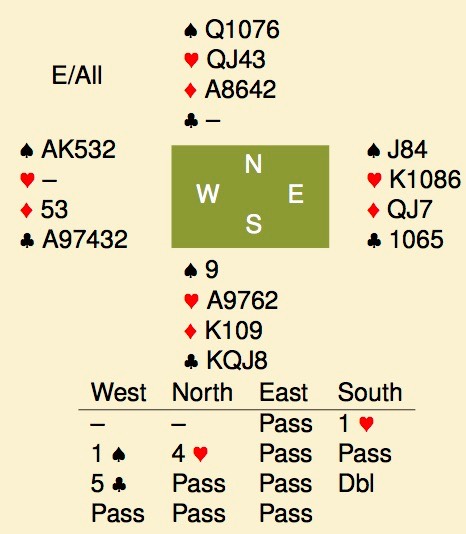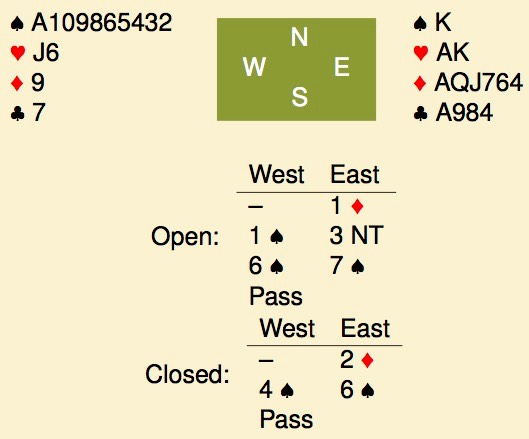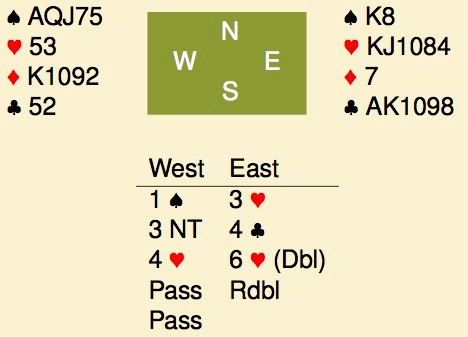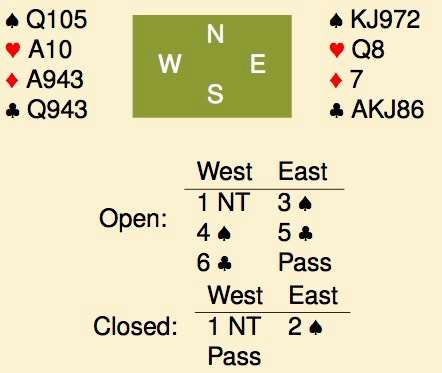Wrapping up the report on the 1930 international test match, with an answer to the obvious question: who won? Earlier episodes can be found by clicking on part 1 and part 2.
As I wrote before, scoring was by total points, simply add up the results by each team in both rooms and whoever scores plus, wins. Today, with IMP’s, overtricks are considered to be of little importance. With this methods, they are even more irrelevant. For example, making 3NT vulnerable against 2NT with an overtrick, nowadays scores 10 imp’s, or 10 overtricks. With total points, the difference is 450 or 15 overtricks.
So, play started and the first scores were in favor of the British team gaining some 600 points. Then this board came up. In open room, with the British EW, their captain picked a rather strange sequence of bids: 1♠ followed by 5♣ not only suggests that the black suit lengths are 6♠ and 5♣ rather than the current 5♠ and 6♣, it also gets you a level higher. On a heart lead, declarer lost 3 trumps, 2 diamonds and a spade, for down 4, or -1400 in the 1930 scoring with -200 for the first and -400 for the subsequent undertricks, 4♠ would have saved an undertrick.
In open room, with the British EW, their captain picked a rather strange sequence of bids: 1♠ followed by 5♣ not only suggests that the black suit lengths are 6♠ and 5♣ rather than the current 5♠ and 6♣, it also gets you a level higher. On a heart lead, declarer lost 3 trumps, 2 diamonds and a spade, for down 4, or -1400 in the 1930 scoring with -200 for the first and -400 for the subsequent undertricks, 4♠ would have saved an undertrick.
In the replay, south was left to play 4♥. West led the ♠K and continued with the ♣4. That looks strange, I’d think most players would continue with the ♦5 for the lack of anything better, but the contract is cold on any continuation. Declarer ruffed the ♣4 and ran the ♥Q, crossed to a diamond and led the ♣K ducked all around. The ♣Q was covered by the ♣A and ruffed. Next a spade ruff back to hand and that is 6 tricks. Declarer now played the ♣J and can always make the contract by ruffing this with the ♥J. If east overruffs, declarer has ♥A97 over ♥108 and can always score 3 more trumps plus the ♦A. If east doesn’t overruff, declarer has 7 tricks with 2 trumps and the ♦A to come.
South somehow missed this and discarded the ♠Q on the ♣J. Now east could ruff small and return the ♥K. Declarer still had to lose 2 tricks for down 1. That was -100, for a total loss of 1500 points. Bidding 4♠x in one room and making 4♥ in the other, would have kept the loss to only 380 points.
As it was, this put the US team ahead for the first time in the match and they never looked back. On day 2, the lead slowly increased to some 4400 points when this fairly unlucky result came up.
The book on bidding 9 card suits had not been written back in 1930 but the final contract is sound as all it requires is a 2-1 spade split (72%) which is well above the 67% requirement for making it a good slam. It wasn’t the American’s day when a defender held ♠QJ7 of trumps and doubled with a sure trump trick. In the replay, the British only bid 6♠. Note the 2_ opener and compare it to board 39 in the previous episode. This hand looks a lot stronger than the 3♠ bid there, though systematically it should be the other way around.
That reduced the lead to 2700 points. However, the Americans weren’t impressed by this and just continued to play better picking up points on most hands. 10 boards later, the lead was back in the 4,000 point region.  Not much changed over the next 3 days, the Americans simply played better on most boards, though with an occasional miss due to the primitive bidding methods. Here they are sitting EW and this was the auction.
Not much changed over the next 3 days, the Americans simply played better on most boards, though with an occasional miss due to the primitive bidding methods. Here they are sitting EW and this was the auction.
South surely didn’t realize that north could open this light, the hand is not an opening bid in the 1930 Culbertson system, and his last 2 bids are totally off the wall. Down 3 for -800. In the other room a more sensible 3NT was bid and made. Despite this set-back, the American lead remained somewhere in the 4000 to 5000 points region.
The British finally put the nail into their own coffin on this board:
Note the weak NT in both rooms, that is not an error or a new convention, it is simply the result of the hand evaluation of the day: 2 aces and stoppers in all suits, make it a strong NT. Points? Nobody had even heard of them.
In the open room, the US east then made the forcing bid of 3♠ and did well to make an other move over 4♠, leading to the unbeatable 6♣ contract. Closed, the British seemed to have a misunderstanding over the strength of 2♠ and ended up in a partial.
The Americans relaxed a bit on the last day and the margin dropped a bit, but the result was never in doubt, a clear win mainly due to better and more consistent bidding. Vastly superior seems like a good way to describe it.
